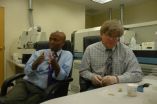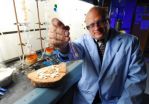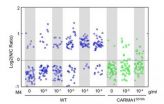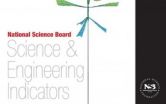(Press-News.org) Cave-diving scientist Patricia A. Beddows of Northwestern University is a member of an international team of researchers and cave divers this week announcing the discovery in an underwater Yucatán Peninsula cave of one of the oldest human skeletons found in North America.
Details of "Naia," a teenage girl who went underground to seek water and fell to her death in a large pit named Hoyo Negro ("black hole" in Spanish), will be published May 16 in the journal Science.
"The preservation of all the bones in this deep water-filled cave is amazing -- the bones are beautifully laid out," said Beddows, who has hovered underwater above the skeleton's site and prospected in the area. "The girl's skeleton is exceptionally complete because of the environment in which she died -- she ended up in the right water and in a quiet place without any soil. Her pristine preservation enabled our team to extract enough DNA to determine her shared genetic code with modern Native Americans."
Beddows, a native of Canada fluent in English, Spanish and French, is available to talk to reporters under embargo and can discuss her experience as one of the two cave-diving scientists who have been underwater at the site. She also can share her expertise on the formation of the caves, the distribution and movement of groundwater at Hoyo Negro and sediments at the site and on the skeleton.
Beddows can be reached at office 847-491-7460, cell 224-420-0977 or patricia@earth.northwestern.edu.
Now covered by water, the girl's skeleton is between 13,000 and 12,000 years old and establishes a shared ancestry between the earliest Americans and modern Native Americans. Genetic analysis shows the prehistoric girl and living Native Americans came from the same place during the initial peopling of the Americas. The near-complete human skeleton -- with an intact cranium and preserved DNA -- was discovered lying 130 feet below sea level near a variety of extinct animals, including an elephant-like creature called a gomphothere. These remains helped scientists establish the age of the skeleton.
Led by Pilar Luna of the Mexican government's National Institute of Anthropology and History (INAH) and James Chatters of Applied Paleoscience, 15 experts from a wide range of fields have been focused on telling the story of the young woman and Hoyo Negro since the skeleton's discovery in 2011.
Beddows' expertise regarding the Hoyo Negro discovery is focused on three areas:
Cave formation. "Hoyo Negro is a very complex site," Beddows said. "By understanding the formation of the shallow caves and the shaft into which the girl fell, we know that the girl and the animals visited a site that looks almost like it does today, except that the water level was down in the bottom of the shaft."
Hydrogeology. Beddows' studies starting in the mid-1990s have shown how these extensive caves effectively drain groundwater to the coasts and, more specifically, how the water level in the caves matches sea level very closely. "Using this knowledge, we understand how Hoyo Negro has changed over thousands of years," Beddows said.
Recrystalized rock sediments. The rocks and the skeletons in Hoyo Negro have valuable rock crystals lying on them, including a new form of impressive crystal growing on them that Beddows calls "florets," in recognition of their bushy nature and one-inch size. "An impressive aspect of this research is that we have dated the skeleton directly, but we also have supported these dates with additional dates on the florets," Beddows said.
Her research focuses specifically on cave systems that are carved by dissolution of soluble carbonate rocks like limestone and dolomite, and her biggest research concentration is the flooded caves of the Yucatán Peninsula, including Hoyo Negro.
"Research in flooded caves is much like space exploration, with divers similar to astronauts reporting back to 'mission control' -- a much larger scientific team at the surface," Beddows said. "It all has to be done on SCUBA, which is our life support system. Our science team has been supported by a great number of dedicated non-science cave divers who have committed hundreds of hours at very dangerous depths to complete this exploration."
INFORMATION:
Beddows is assistant chair and assistant professor of instruction in the department of Earth and planetary sciences in Northwestern's Weinberg College of Arts and Sciences.
The National Geographic Society supported the research. Its embargoed press release is available in the SciPak package or by contacting press officer Claire Jones at (202) 857-7756 or
cgjones@ngs.org.
One of oldest human skeletons in North America is discovered
Cave-diving scientist on team is available to discuss discovery and its underwater site
2014-05-15
ELSE PRESS RELEASES FROM THIS DATE:
Communicating with the world across the border
2014-05-15
Stanford, CA—All living cells are held together by membranes, which provide a barrier to the transport of nutrients. They are also the communication platform connecting the outside world to the cell’s interior control centers. Thousands of proteins reside in these cell membranes and control the flow of select chemicals, which move across the barrier and mediate the flux of nutrients and information. Almost all of these pathways work by protein handshakes--one protein “talking” to another in order to, for example, encourage the import of a needed nutrient, to block a compound ...
Quantum simulator gives clues about magnetism
2014-05-15
Assembling the puzzles of quantum materials is, in some ways, like dipping a wire hanger into a vat of soapy water, says CIFAR (Canadian Institute for Advanced Research) Fellow Joseph Thywissen (University of Toronto).
Long before mathematical equations could explain the shapes and angles in the soap foams, mathematicians conjectured that soap films naturally found the geometry that minimized surface area, thus solving the problem of minimal surfaces. They could be created simply by blowing soap bubbles.
At the University of Toronto's Ultracold Atoms Lab, Thywissen ...
UNM plays major role in establishing link between ancient and modern Native-Americans
2014-05-15
Her name is Naia, and for thousands and thousands of years, the skeleton of this young woman was buried underwater in an elaborate cave system in the Yucatan Peninsula after she had apparently fallen into what was then a dry deep pit.
Now, a team of researchers, including Professor Yemane Asmerom and Research Scientist Victor Polyak at the University of New Mexico's Department of Earth and Planetary Sciences, have accurately determined the age of the oldest-known, well-preserved human skeleton. Naia was one of the earliest inhabitants of the Americas and has helped resolve ...
Making money from lignin: Roadmap shows how to improve lignocellulosic biofuel biorefining
2014-05-15
When making cellulosic ethanol from plants, one problem is what to do with a woody agricultural waste product called lignin. The old adage in the pulp industry has been that one can make anything from lignin except money.
A new review article in the journal Science points the way toward a future where lignin is transformed from a waste product into valuable materials such as low-cost carbon fiber for cars or bio-based plastics. Using lignin in this way would create new markets for the forest products industry and make ethanol-to-fuel conversion more cost-effective.
"We've ...
UH researchers find definitive evidence of how zeolites grow
2014-05-15
Researchers have found the first definitive evidence of how silicalite-1 (MFI type) zeolites grow, showing that growth is a concerted process involving both the attachment of nanoparticles and the addition of molecules.
Both processes appear to happen simultaneously, said Jeffrey Rimer, an engineering professor at the University of Houston and lead author of a paper published Thursday in the journal Science.
He said a second component to the research could have even more lasting impact. He and researcher Alexandra I. Lupulescu used a new technique allowing them to view ...
Anti-craving drug and counseling lower alcohol harm in homeless, without sobriety demands
2014-05-15
Chronically homeless, alcohol-dependent individuals might benefit from a new intervention that does not require them to stop or even reduce drinking, according to the results of a preliminary study in Seattle.
Participants in the 12-week pilot program received monthly injections of an anti-craving medication, extended-release naltrexone. They also met regularly with study physicians to set their own goals for treatment and to learn to be safer in their use of alcohol.
"Abstinence-based alcohol treatment has not been effective for or desirable to many homeless people ...
UTHealth research: Children of parents in technical jobs at higher risk for autism
2014-05-15
HOUSTON – (May 15, 2014) – Children of fathers who are in technical occupations are more likely to have an autism spectrum disorder, according to researchers at The University of Texas Health Science Center at Houston (UTHealth).
The findings will be presented Friday at the International Meeting for Autism Research in Atlanta.
During participation in the LoneStar LEND program, first author Aisha S. Dickerson, Ph.D., a researcher at UTHealth's Center for Clinical and Translational Sciences, used the United States government's Standard Occupational Classification system. ...
B cells produce antibodies 'when danger calls, but not when it whispers'
2014-05-15
The immune system's B cells protect us from disease by producing antibodies, or "smart bullets," that specifically target invaders such as pathogens and viruses while leaving harmless molecules alone. But how do B cells determine whether a threat is real and whether to start producing these weapons?
An international team of life scientists shows in the May 16 issue of the journal Science how and why these cells respond only to true threats.
"It is critical for B cells to respond either fully or not at all. Anything in between causes disease," said the study's senior ...
Researchers show emissions from forests influence very first stage of cloud formation
2014-05-15
PITTSBURGH—Clouds play a critical role in Earth's climate. Clouds also are the largest source of uncertainty in present climate models, according to the latest report of the Intergovernmental Panel on Climate Change. Much of the uncertainty surrounding clouds' effect on climate stems from the complexity of cloud formation.
New research from scientists at the CLOUD (Cosmics Leaving OUtdoor Droplets) experiment at CERN, including Carnegie Mellon University's Neil Donahue, sheds light on new-particle formation — the very first step of cloud formation and a critical component ...
New data show how states are doing in science
2014-05-15
The newly updated, online, interactive state data tool allows policymakers, educators and other users to discern trends in education, science and research in each of the 50 states. This free resource supplements the state data in the 2014 Science and Engineering Indicators report, the premier source of information and analysis of the nation's position in science and engineering education and research. The biennial report is published by the National Science Board, the policy making body of the National Science Foundation (NSF).
The tool features 59 state indicators of ...
LAST 30 PRESS RELEASES:
SIMJ announces global collaborative book project in commemoration of its 75th anniversary
Air pollution exposure and birth weight
Obstructive sleep apnea risk and mental health conditions among older adults
How talking slows eye movements behind the wheel
The Ceramic Society of Japan’s Oxoate Ceramics Research Association launches new international book project
Heart-brain connection: international study reveals the role of the vagus nerve in keeping the heart young
Researchers identify Rb1 as a predictive biomarker for a new therapeutic strategy in some breast cancers
Survey reveals ethical gaps slowing AI adoption in pediatric surgery
Stimulant ADHD medications work differently than thought
AI overestimates how smart people are, according to HSE economists
HSE researchers create genome-wide map of quadruplexes
Scientists boost cell "powerhouses" to burn more calories
Automatic label checking: The missing step in making reliable medical AI
Low daily alcohol intake linked to 50% heightened mouth cancer risk in India
American Meteorological Society announces Rick Spinrad as 2026 President-Elect
Biomass-based carbon capture spotlighted in newly released global climate webinar recording
Illuminating invisible nano pollutants: advanced bioimaging tracks the full journey of emerging nanoscale contaminants in living systems
How does age affect recovery from spinal cord injury?
Novel AI tool offers prognosis for patients with head and neck cancer
Fathers’ microplastic exposure tied to their children’s metabolic problems
Research validates laboratory model for studying high-grade serous ovarian cancer
SIR 2026 delivers transformative breakthroughs in minimally invasive medicine to improve patient care
Stem Cell Reports most downloaded papers of 2025 highlight the breadth and impact of stem cell research
Oxford-led study estimates NHS spends around 3% of its primary and secondary care budget on the health impacts of heat and cold in England
A researcher’s long quest leads to a smart composite breakthrough
Urban wild bees act as “microbial sensors” of city health.
New study finds where you live affects recovery after a hip fracture
Forecasting the impact of fully automated vehicle adoption on US road traffic injuries
Alcohol-related hospitalizations from 2016 to 2022
Semaglutide and hospitalizations in patients with obesity and established cardiovascular disease
[Press-News.org] One of oldest human skeletons in North America is discoveredCave-diving scientist on team is available to discuss discovery and its underwater site








